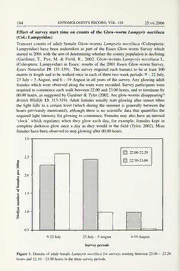
Effect of survey start time on counts of the glow-worm Lampyris noctiluca (Col.: Lampyridae) PDF
Preview Effect of survey start time on counts of the glow-worm Lampyris noctiluca (Col.: Lampyridae)
184 ENTOMOLOGIST'SRECORD,VOL. 118 25.vii.2006 Effect of survey start time on counts of the Glow-worm Lampyris noctiluca (Col.: Lampyridae) Transect counts of adult female Glow-worms Lampyris noctiluca (Coleoptera: Lampyridae) have been undertaken as part of the Essex Glow-worm Survey which startedin 2001 withthe aimofdeterminingwhetherthecountypopulationis declining (Gardiner, T., Pye, M. & Field, R., 2002. Glow-worms Lampyris noctiluca L. (Coleoptera: Lampyridae) in Essex: results of the 2001 Essex Glow-worm Survey. Essex Naturalist 19: 151-159). The survey required each transect to be at least 100 metres inlength andtobe walkedonce ineach ofthree two-weekperiods: 9-22July, 23 July - 5 August, and 6-19 August in all years ofthe survey. Any glowing adult females which were observed along the route were recorded. Survey participants were required to commence each walkbetween 22.00 and 23.00 hours, and to terminate by 00.00 hours, as suggested by Gardiner & Tyler (2002. Are glow-worms disappearing? British Wildlife 13: 313-319). Adult females usually start glowing after sunset when the light falls to a certain level (which during the summer is generally between the hours previously mentioned), although there is no scientific data that quantifies the required light intensity for glowing to commence. Females may also have an internal ‘clock’ which regulates when they glow each day, for example, females kept in complete darkness glow once a day as they would in the field (Tyler, 2002). Most femaleshavebeenobservedtostopglowingafter00.00hours. Surveyperiods Figure 1. Density ofadult female Lampyris noctiluca for surveys starting between 22.00- 22.29 hoursand22.30-23.00hoursinthethreesurveyperiods. NOTES 185 A slow strolling pace (average walking/searching speed was 0.7 km/hour) was recommendedforthe walks to reduce theriskofoverlooking glowing females along theroute. Mostwalks werefairly shortinduration (average surveytimeof37 min). It has become evident that survey start time has a significant effect on counts of females. Inperiod 1, there was noreal differencebetweencounts ofglowing females from surveys that started between 22.00-22.29 hours and 22.30-23.00 (Figure 1). Sunsettimes (forLondon) forthis period were 21.16 on 9 July and 21.03 on 22July, so most surveys were starting approximately one hour after sunset. However, as the monitoring progressed into late July/early August (periods 2 and 3), surveys that started between 22.30-23.00 yielded extremely low counts in comparison to those commenced between 22.00-22.29 h (Figure 1). As sunset times became earlier in periods 2 (21.02 on 23 July, 20.41 on 5 August) and 3 (20.40 on 6 August, 20.15 on 19 August) itis clearthat less females were seen after22.30 hours. This may be due to earlier ‘lighting up’ times in late summer(othersurveys foundfemales glowing as early as 21.35 and 21.00 in periods 2 and 3 respectively) leading to the majority of females having mated and stopped glowing (Tyler, 2002. The Glow-worm. Lakeside Press, Sevenoaks), beforethelatersurveys, after22.30, commenced. In conclusion it is crucial that criteria for surveying glowing females reflect the earliersunsetand ‘lightingup’ times (offemales) in lateJuly/August. Surveys inlate July/August should start as close to 22.00 h as possible to avoid low counts of glowing females. It is also important to remember that the light level needs to have fallen sufficiently (e.g. difficult to make—out colours) before females ‘light up’ and the survey can commence (Tyler, 2002). Tim Gardiner, Centre for Environment & Rural Affairs (CERA), Writtle College, Lordship Road, Writtle, Chelmsford, EssexCM1 3RR (E-mail: [email protected]). Hazardsofbutterfly collecting. From theNilgiri totheBiligirirangaMountains, SouthIndia, 1986 On 30 May, 1986 I woke up in a rathercrummy guest house ofthe Glenbum Estate in the Nilgiri Mountains in southern India - I had already been advised that the better one was being renovated. I had been rudely expelled from my comfortable lodgings 30km away in Kotagiri and 600m up. Actually, rudely is not the correct term. When I took up residence for six months in Kotagiri at the old boarding- school, where I had earlier lived between the ages of 10 and 14, I was warned that my stay would be disrupted. The caveat was issued by the last Danish missionaries in India - two splendid ladies running a couple of universally acclaimed secondary schoolsforgirlsinTamilNadu. My eviction had been tempered by the ladies bringing me a huge stack ofDanish newspapers and magazines. My aspirations for the first day in exile were simple. I would sit on the porch, i.di ring the splendid view, dipping into thejack-fruit that had thoughtfully beenprovided by my host, andperusing the Danishpress. This was nottobe.
